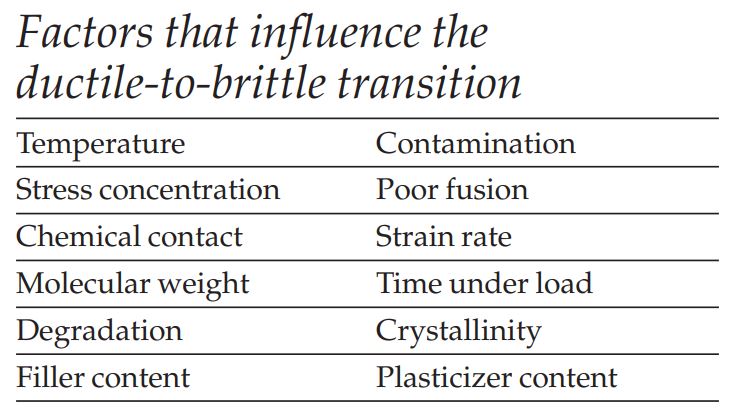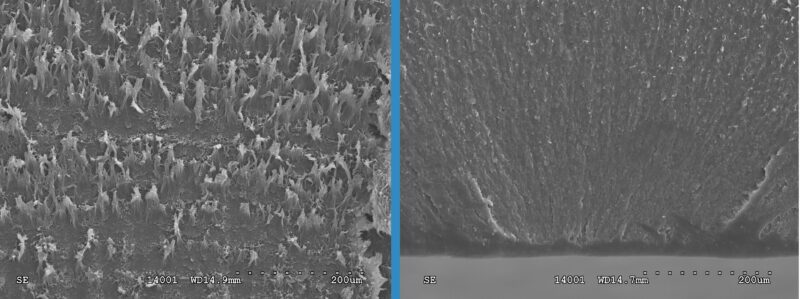These articles originally appeared in Advanced Materials & Processes – February 2006 and February 2007
Failure analysis of polymers often shows that the part failed after the material changed from a ductile to a brittle microstructure.
 The goal of a failure analysis, regardless of the material, is to identify the mode and cause of the failure. The assignment of the failure mode, such as fatigue, overload, or environmental stress cracking, is often straightforward through standard fractographic methods. However, the determination of the cause of the failure is often less apparent, particularly with a plastic component. This article discusses the failure modes of thermoplastic resins. Many factors influence a ductile-to-brittle transition within plastic materials, as shown in the table.
The goal of a failure analysis, regardless of the material, is to identify the mode and cause of the failure. The assignment of the failure mode, such as fatigue, overload, or environmental stress cracking, is often straightforward through standard fractographic methods. However, the determination of the cause of the failure is often less apparent, particularly with a plastic component. This article discusses the failure modes of thermoplastic resins. Many factors influence a ductile-to-brittle transition within plastic materials, as shown in the table.
These factors are associated with material, processing, design, and service issues. Over the course of this article and the subsequent installment, several key factors will be reviewed, including temperature, chemicals, and environment.
Thermoplastic resins are utilized in many applications because of their unique property set, including ductile response to applied stress. This ductility is associated with the viscoelastic nature of polymers, and is attributed to their unique molecular structure. In spite of that inherent ductility, most plastic components fail through one of the many brittle fracture modes.

Comparison of polyethylene crack surfaces exhibiting ductile (left) and brittle (right) fracture features.
In my experience, having conducted over 5000 plastic component failure analyses, less than 5% were associated with ductile overload. The remainder represent brittle fractures of normally ductile materials. Therefore, within evaluations of plastic component failures, the focus of the investigation frequently turns to identifying the nature of the ductile-to-brittle transition. The objective of the successful evaluation becomes to identify the source of the brittle behavior. This relatively brittle response to stress is evident through the examination and characterization of
the fracture surface morphology.
To understand the cause of a ductile-to-brittle transition, the analyst must first understand the mechanism that causes plastic materials to crack. Cracking is simply a response to mechanical stresses, either internal or external. Contrary to widespread opinion, cracking of a resin does not represent the scission of the polymer molecules. Molecular degradation mechanisms such as oxidation and chemical attack can render the altered material susceptible to failure. However, plastic resins do not crack through mechanisms that produce gross breakage of individual polymer chains. Although mechanical stress does result in a limited amount of chain scission, the primary response is molecular disentanglement, sometimes referred to as slippage. In fact, cracking within
a molded plastic resin represents the disentanglement of the molecular structure by overcoming the intermolecular forces holding the molecules together. These forces include Van der Waals forces and hydrogen bonding.
In ductile failure, the mechanism that ultimately results in cracking includes several steps: linear elastic deformation, nonlinear elastic deformation, yielding, necking, plastic deformation, and failure. Each of these steps is associated with physical alteration of the molecular structure.
Factors that influence the ductile-to-brittle transition include
- Temperature
- Contamination
- Stress concentration
- Poor fusion
- Chemical contact
- Strain rate
- Molecular weight
- Time under load
- Degradation
- Crystallinity
- Filler content
- Plasticizer content
